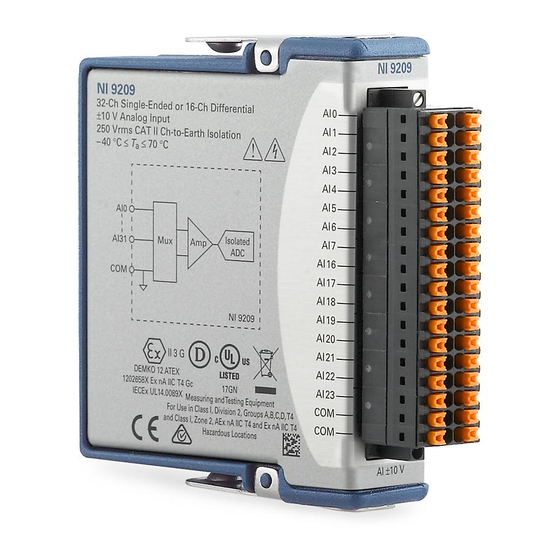Summary of Contents for National Instruments NI 9209
- Page 1 GETTING STARTED GUIDE NI 9209 16 AI Differential/32 AI Single-Ended, ±10 V, 24 Bit, 500 S/s Aggregate...
-
Page 2: Safety Guidelines
This document explains how to connect to the NI 9209. In this document, the NI 9209 with spring terminal and the NI 9209 with DSUB are referred to inclusively as the NI 9209. Before you begin, complete the software and... -
Page 3: Ni 9209 With Spring Terminal Safety Voltages
115 V for U.S. or 230 V for Europe. Do not connect the NI 9209 to signals or use Caution for measurements within Measurement Categories III or IV. NI 9209 Getting Started Guide | © National Instruments | 3... -
Page 4: Ni 9209 With Dsub Safety Voltages
This category is for measurements of voltages from specially protected secondary circuits. Such voltage measurements include signal levels, special equipment, limited-energy parts of equipment, circuits powered by regulated low-voltage sources, and electronics. 4 | ni.com | NI 9209 Getting Started Guide... -
Page 5: Safety Guidelines For Hazardous Locations
CAT III, or CAT IV. Safety Guidelines for Hazardous Locations The NI 9209 is suitable for use in Class I, Division 2, Groups A, B, C, D, T4 hazardous locations; Class I, Zone 2, AEx nA IIC T4 and Ex nA IIC T4 hazardous locations; and nonhazardous locations only. - Page 6 II 3G and is suitable for use in Zone 2 hazardous locations, in ambient temperatures of -40 °C ≤ Ta ≤ 70 °C. If you are using the NI 9209 in Gas Group IIC hazardous locations, you must use the device in an NI chassis that has been evaluated as Ex nC IIC T4, Ex IIC T4, Ex nA IIC T4, or Ex nL IIC T4 equipment.
-
Page 7: Electromagnetic Compatibility Guidelines
This product is intended for use in industrial locations. However, harmful interference may occur in some installations, when the product is connected to a peripheral device or test object, or if the NI 9209 Getting Started Guide | © National Instruments | 7... -
Page 8: Special Conditions For Marine Applications
To ensure the specified EMC performance, Caution operate the NI 9209 with DSUB only with shielded cables and accessories. Do not use unshielded cables or accessories unless they are installed in a shielded... -
Page 9: Preparing The Environment
EMC performance is attained. Preparing the Environment Ensure that the environment in which you are using the NI 9209 meets the following specifications. Operating temperature -40 °C to 70 °C... - Page 10 Indoor use only. Refer to the device datasheet on ni.com/manuals Note for complete specifications. 10 | ni.com | NI 9209 Getting Started Guide...
- Page 11 AI25 AI16 AI18 AI26 AI24 AI17 AI25 AI19 AI27 AI18 AI26 AI20 AI28 AI19 AI27 AI20 AI21 AI29 AI28 AI21 AI22 AI30 AI29 AI22 AI30 AI23 AI31 AI23 AI31 NI 9209 Getting Started Guide | © National Instruments | 11...
- Page 12 No connection Signals You can connect single-ended or differential signals to the NI 9209. Use a differential measurement configuration to attain more accurate measurements and less noise. The following table shows the signal pairs that are valid for differential connection configurations with the NI 9209.
- Page 13 Table 2. Differential Pairs Channel AI + AI10 AI11 AI12 AI13 AI14 AI15 AI16 AI24 AI17 AI25 AI18 AI26 NI 9209 Getting Started Guide | © National Instruments | 13...
-
Page 14: Grounded Differential Connections
Table 2. Differential Pairs (Continued) Channel AI + AI19 AI27 AI20 AI28 AI21 AI29 AI22 AI30 AI23 AI31 Grounded Differential Connections Voltage Source – AI– NI 9209 14 | ni.com | NI 9209 Getting Started Guide... -
Page 15: Floating Differential Connections
Connect the negative lead to COM through a 1 MΩ resistor to keep the signal source within the common-mode voltage range. The NI 9209 does not read data accurately if the signal source is outside of the common-mode voltage range. -
Page 16: Single-Ended Connections
Connect the ground signal to COM to keep the signal source within the common-mode voltage range. NI 9209 Connection Guidelines • Make sure that devices you connect to the NI 9209 are compatible with the module specifications. • You must use 2-wire ferrules to create a secure connection when connecting more than one wire to a single terminal on the NI 9209 with spring terminal. -
Page 17: High-Vibration Application Connections
The NI 9209 provides overvoltage protection for each channel. Only one channel can be in an overvoltage condition at a time. Refer to the device datasheet on ni.com/manuals Note for more information about overvoltage protection. NI 9209 Getting Started Guide | © National Instruments | 17... -
Page 18: Where To Go Next
NI 9209 Datasheet NI 9209 Datasheet NI-RIO Help NI-DAQmx Help LabVIEW FPGA Help LabVIEW Help RELATED INFORMATION C Series Documentation Services & Resources ni.com/services ni.com/info cseriesdoc Located at ni.com/manuals Installs with the software 18 | ni.com | NI 9209 Getting Started Guide... -
Page 19: Worldwide Support And Services
You can obtain the DoC for your product by visiting ni.com/certification. If your product supports calibration, you can obtain the calibration certificate for your product at ni.com/calibration. NI 9209 Getting Started Guide | © National Instruments | 19... - Page 20 U.S. Government Customers: The data contained in this manual was developed at private expense and is subject to the applicable limited rights and restricted data rights as set forth in FAR 52.227-14, DFAR 252.227-7014, and DFAR 252.227-7015. © 2015—2016 National Instruments. All rights reserved. 376909D-01 Sep16...










Need help?
Do you have a question about the NI 9209 and is the answer not in the manual?
Questions and answers